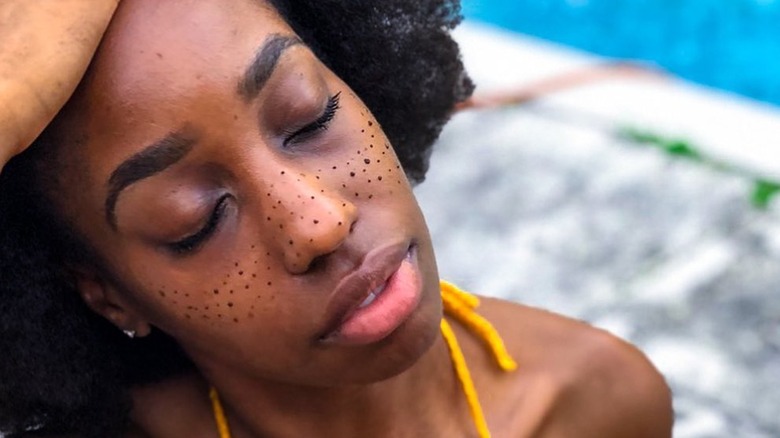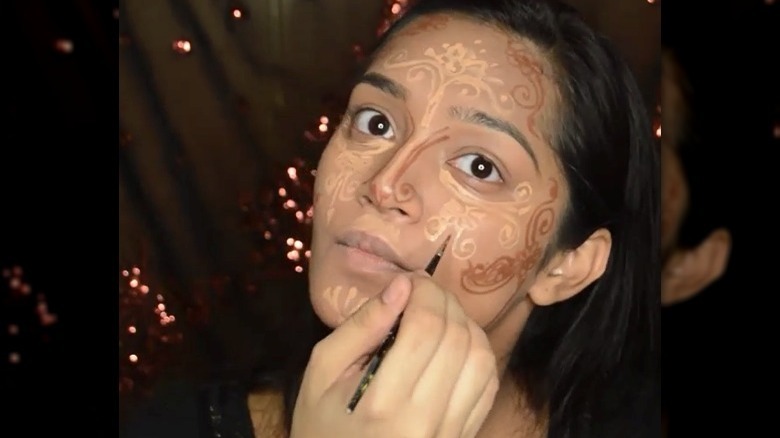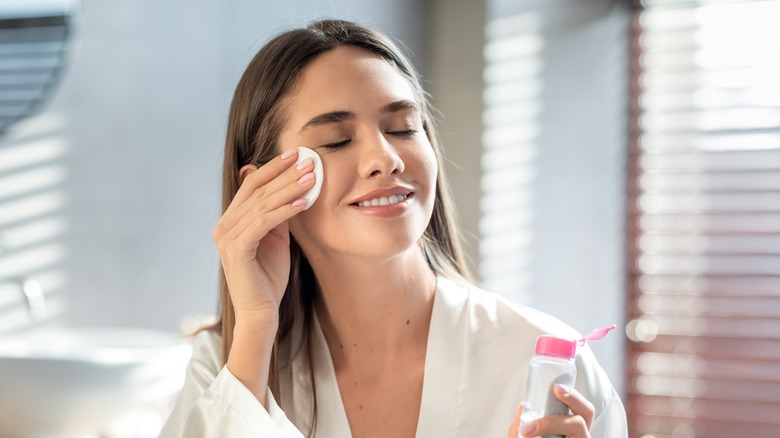Henna Contour Is The Latest High-Risk, High-Reward Makeup Trend
Still setting aside an hour to perfect your makeup each morning? You might want to reconsider your routine. Full-on glam may have had its moment in the sun, but it's clear that the no-makeup makeup look is catching on across the globe. In place of multi-step tutorials and heavy, layered cosmetics, modern beauty lovers are turning to multi-use lightweight products that can be applied instantly. Nevertheless, one stage makeup trick is still going strong despite the changing tides. Contouring, the face-sculpting technique developed by the drag community and beloved by makeup fans everywhere, is just as popular as ever.
But how does one fulfill their contouring fantasies while keeping their makeup light and fresh? By using henna, of course. The ancient art form, traditionally used to create intricate designs on the body, is an endless source of inspiration for many makeup artists. What's more, it isn't the first time henna has made the rounds in the beauty sphere for its versatile, long-lasting effects. You may have heard about henna freckles, a variation of the faux freckles trend. The use of henna freckles has drawn both raised eyebrows and praise within the beauty community, but henna contour is the latest technique to make waves on social media. Want to find out more on how to use henna as contour? We'll show you everything you need to know about this viral trend.
Using henna as contour
There are several ways to incorporate henna into your contouring routine. One of the simplest methods involves applying broad, paint-like strokes of henna to define your face. TikTok user Zfen demonstrates that this technique is easy to execute with little more than a pair of gloves and prepared henna paste. Alternatively, you can use a concealer or foundation brush for a more precise contouring application. Some users leave the henna on the skin for an hour or two, while others prefer to let the dye rest for up to five hours before peeling or rinsing off with cold water. Henna's effects generally last about two weeks, although it may fade faster if you regularly exfoliate or use brightening skincare products.
Thinking of delving into the world of henna contour? Before getting started, make sure you select a pure henna product without any additives. "There are many kinds of henna, such as red henna and black henna — both of which are extremely harmful to use on skin," Henna Studio founder Zoiya Wahidi tells Ipsy. "They contain chemicals such as p-phenylenediamine (PPD), which can severely burn the skin and leave life-long burn marks."
Even when using natural henna powder, it's crucial to perform a patch test on the skin. After mixing your henna and allowing it to develop, apply a small amount just behind the ear or on your inner wrist. Lastly, wait 24-48 hours to see if any irritation develops before using it as a contour.
Contouring with henna freckles
If you haven't noticed, freckles are seriously in vogue. Of course, anyone who's applied faux freckles knows how time-consuming the stippling process can be. Henna freckles are a popular, semi-permanent alternative to cosmetic freckle pens and markers. Like henna contour, henna freckles can last up to two weeks before needing a touch-up. Although many apply the spots sparingly across the nose and cheeks, contouring fans strategically place dense clusters of freckles to achieve a sculpted look. This style of henna contour requires slightly more patience and precision than basic techniques but produces a desirable gradient effect.
Just as you would with regular henna contour, always use a pure, natural henna powder and perform a patch test before using henna for freckles. For the most natural-looking freckles, employ a precise applicator, like a needle-tip squeeze bottle or a fine detail brush. You'll want to include some variety in your faux freckles' shape, size, and distribution, so don't be afraid to make a mistake or two. Apply the freckles in the same areas you'd use your favorite contouring shadow, from the bridge of the nose to the curves of the cheeks and jawline. The result? Beautiful, lasting freckles that can be worn alone or enhanced with a hint of blush or bronzer.
Henna contour for sensitive skin
While it's clear that henna can produce impressive results in the way of contouring, it has a few potential risks. First, there's the fact that henna is semi-permanent — so any undesirable effects will be hard to hide for a few days to weeks. Moreover, even in its purest form, some people find that henna doesn't sit well with their skin type. If you have sensitive skin but dream of using henna contour, don't despair. You can still join in the fun of henna contouring with products you might already have at home.
Makeup artists like Sahur Saleim have perfected the craft of henna-inspired contouring using everyday cosmetics instead of the herbal paste. Not sure you can pull it off? Fortunately, this contouring technique is easier than it looks. "I would say make sure to use concealers with a more liquid consistency so it's easier to apply," Saleim told Marie Claire. "I used the LA Girl Pro-Conceal in Espresso to contour and a MAC Pro Longwear Concealer in NC42 to highlight. I applied them on my face with very thin paintbrushes that I normally use on paintings."
From there, prep and prime your face as you would normally, and use a reference photo — or your imagination — to paint on henna-inspired designs. Finally, lightly blend the lines with a brush or beauty blender, and set the look with your favorite powder or finishing spray.
How to safely remove henna contour
Not a fan of your new look? While makeup can be easily washed away with double cleansing, actual henna pigment is a little trickier to take off. That said, it's not impossible to get rid of, and there are several methods for removing henna dye from your skin. Chances are you have some type of skin-friendly oil at home, and virtually any variety can be used to break down the henna pigment. Still, not all oils are created equally. Heavier oils like coconut can be comedogenic, meaning they're more likely to cause milia or whiteheads. To err on the side of caution, try to use an oil-based cleaner or a non-comedogenic oil, such as rosehip oil.
If you're still struggling with henna stains on your skin, you can also use gentle exfoliation to move things along. Physical exfoliants, like scrubs or washcloths, help slough off skin cells at the surface level. Furthermore, chemical exfoliants like glycolic or succinic acid can also remove henna stains by sweeping away dead skin. To prevent over-exfoliating your skin, use a mild moisturizer and SPF 30 or higher sunscreen daily. Regardless of which removal method you choose, remember that any lingering henna contour will naturally fade from the skin within a week or two.


